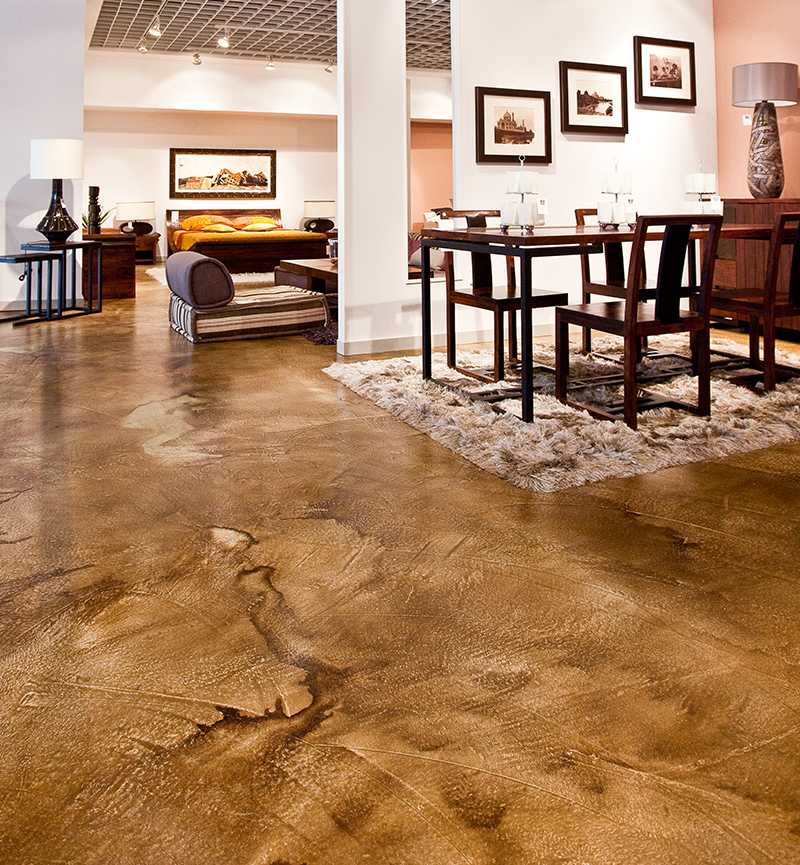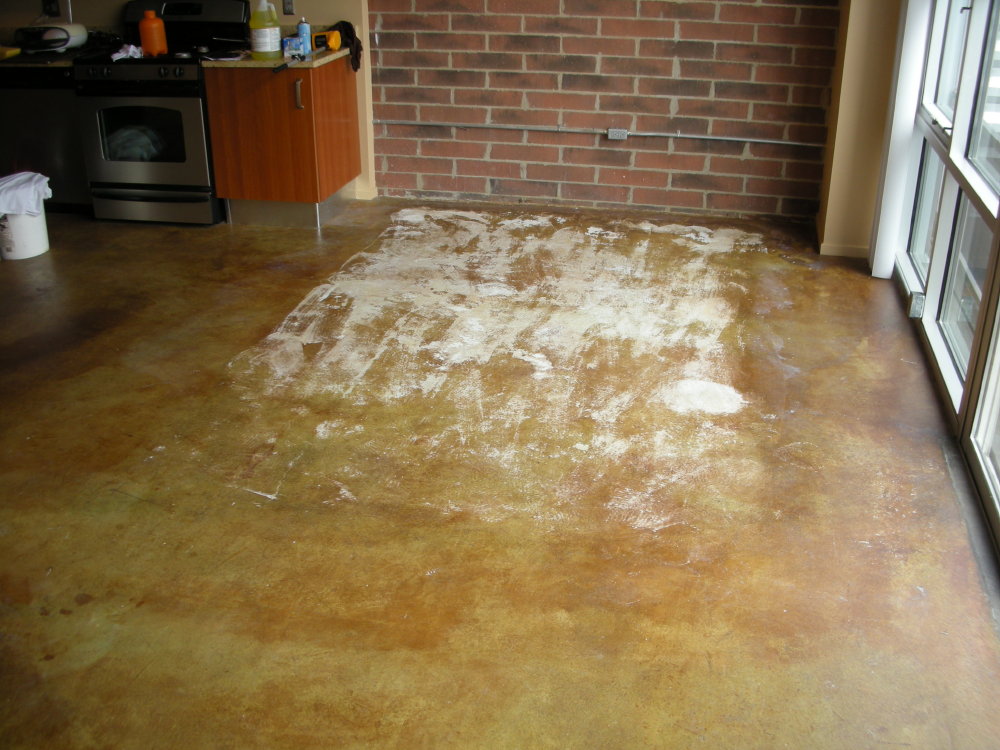Why stained concrete floors outlast other options in durability
Comprehending the Different Kinds of Stained Concrete for Your Following Project
Stained concrete deals numerous alternatives that satisfy different visual and useful requirements. Each kind offers distinct features that affect the last appearance and resilience of the surface area. Recognizing these differences is crucial for anybody preparing a task. From abundant, chemical reactions of acid-based stains to the dynamic harmony of solid shade stains, the options can significantly impact the outcome. What variables should one consider when choosing the optimal tarnish for their certain requirements?
Overview of Stained Concrete
Stained concrete serves as a functional flooring alternative that can improve the aesthetic charm of numerous spaces. This method entails applying a tinting agent to the surface of existing concrete, permitting a broad range of design opportunities. Stained concrete is preferred in both property and commercial settings, providing a sturdy and low-maintenance solution that can simulate the appearance of all-natural products like rock or ceramic tile.
The staining process can be performed using water-based or solvent-based products, each giving distinct visual results. The final look is affected by variables such as the original concrete surface area, the kind of discolor made use of, and the application approach. Stained concrete not just beautifies exterior and interiors but likewise promotes sustainability by rejuvenating existing concrete structures. Because of this, it has actually acquired grip amongst home owners and developers looking for both capability and style in their floor covering selections.
Acid-Based Stains: Characteristics and Benefits

Distinct Shade Variations
Concrete surface areas can change drastically with the application of acid-based stains, which supply an abundant palette of one-of-a-kind shade variants. These stains penetrate the concrete, reacting chemically to create vivid planet tones that vary from deep browns and reds to soft greens and blues. The resulting colors are usually variegated, creating a natural, marble-like look that boosts the concrete's personality. Each application returns distinct outcomes due to variants in the concrete's structure and the staining technique utilized, making every job special. In addition, acid-based stains can be split or incorporated with other methods to produce personalized styles, enabling personal expression. This flexibility makes acid-based stains a popular choice for both property and industrial applications.
Chain Reaction Described
While lots of aspects contribute to the effectiveness of acid-based stains, the underlying chemical responses play a vital role in their unique qualities and benefits. These stains primarily contain water, acid, and metallic salts. When used to concrete, the acid reacts with the calcium hydroxide in the cement, producing a chemical transformation that causes irreversible color changes. The metallic salts pass through the surface area and bond with the concrete, enabling a variety of hues and tones. This response not just boosts aesthetic appeal yet likewise offers sturdiness, making the color resistant to fading and wear. Furthermore, acid-based stains can develop a variegated finish that simulates natural stone, additional improving their popularity for attractive concrete applications.
Surface Prep Work Significance
Attaining optimal results with acid-based stains depends upon extensive surface area preparation. This essential step warranties that the concrete surface is tidy, without impurities, and correctly profiled for excellent discolor absorption. Any kind of existing sealers, dust, or oils can hinder the chain reaction that creates the wanted color and surface, resulting in irregular or uneven results.
Before using the tarnish, the concrete ought to be mechanically cleaned up or pressure cleaned, complied with by a thorough assessment for fractures or blemishes that may require repair. Furthermore, validating the surface area is effectively dried will improve stain adherence. By prioritizing these primary procedures, the longevity and vibrancy of acid-based stains can be substantially boosted, causing a more visually pleasing and durable coating.
Water-Based Stains: Functions and Advantages

Water-based stains pass through the concrete, providing an extra clear surface that highlights the natural texture and variants of the surface area underneath. They are offered in a vast variety of colors, enabling for innovative flexibility in design. In addition, water-based stains are simpler to tidy up, requiring only water and soap, which simplifies the application process.
Their quick drying time boosts performance, making them a functional choice for both DIY enthusiasts and specialists. In general, water-based stains give an attractive mix of aesthetic flexibility and easy to use homes, making them a popular alternative for concrete improvement projects.
Solid Shade Stains: Vivid Options for a Bold Appearance
Strong color stains supply an efficient option for those seeking to produce a strong and lively visual on concrete surface areas. These stains offer an uniform coloration that can considerably improve the visual appeal of floorings, patio areas, and driveways. Readily available in a vast range of colors, solid color stains permit for imaginative expression, providing to various layout choices.
One of the vital benefits of solid shade stains is their capability to conceal blemishes, offering a fresh and sleek want to maturing concrete - stained concrete floors. In addition, their solution generally consists of UV-resistant buildings, guaranteeing longevity and shade retention even in harsh weather conditions
Application is uncomplicated, needing very little prep work of the concrete surface area. Once used, solid shade stains can be sealed for added defense and shine, further boosting their aesthetic top quality. With their dynamic alternatives, strong color stains are an excellent selection for those going for an impactful and cohesive style.
Semi-Transparent Stains: Accomplishing Depth and Measurement
Semi-transparent stains provide a special approach to boosting concrete surfaces by supplying depth and measurement through various shade options. Recognizing the application techniques is view publisher site essential for accomplishing the wanted effect, while appropriate upkeep practices ensure long life. This section will certainly discover these key facets to make best use of the benefits of semi-transparent staining.
Shade Options Available
A broad range of color options exists for semi-transparent stains, allowing house owners and developers to boost the natural charm of concrete surfaces. These stains can be found in an array of shades, from earthy tones like browns and terracottas to vivid colors such as blues and eco-friendlies. The semi-transparent nature of these stains permits the underlying concrete to reveal via, developing an unique deepness and dimension that can complement various design looks. In addition, incorporating various colors can create customized shades, allowing a tailored try to find each job. This versatility makes semi-transparent stains a prominent choice for both exterior and interior applications, as they can integrate with surrounding components while adding visual interest to ordinary concrete.
Application Methods Described
To attain the preferred depth and dimension with semi-transparent stains, proper application techniques are essential. Surface preparation is crucial; the concrete must be tidy and complimentary of any type of contaminants. This commonly includes power washing and fixing any type of splits. Next off, choosing the best applicator, such as a sprayer, roller, or brush, can influence the last look. Sprayers permit an extra even application, while rollers can help achieve structure. It is essential to use the tarnish in slim, also coats, allowing each layer to completely dry prior to adding an additional. Controling the application method, such as differing pressure or using various tools, can develop distinct results. Sealing the stained surface area enhances the vibrancy of the shades while giving defense.
Upkeep Finest Practices
Normal maintenance is important for maintaining the beauty and stability of surface areas treated with semi-transparent stains. To maintain these surfaces, regular cleaning is crucial. Making use of a pH-neutral cleaner and a soft-bristle broom will aid remove dirt and particles without damaging the stain. It is a good idea to stay clear of harsh chemicals, as they can deteriorate the discolor's appearance. Furthermore, routine resealing every one to 3 years can secure versus wear and fading. This process involves cleaning up the surface extensively and applying a suitable sealant created for stained concrete. Property owners should likewise keep track of for any type of indications of staining or damages and address these concerns without delay to assure long-lasting vibrancy and toughness. Following these best methods will improve the general life expectancy of semi-transparent stained surfaces.
Impacts and Methods: Personalizing Your Stained Concrete
Personalizing stained concrete includes a range of methods that enhance both aesthetics and functionality. Amongst these approaches, layering various discolor colors can create deepness and intricacy, enabling one-of-a-kind aesthetic impacts. Techniques such as acid staining give a variegated appearance, while water-based stains offer a more uniform look.
Additionally, incorporating decorative patterns, such as stenciling or engraving, can even more personalize the surface area, including elaborate designs that deal with private tastes. Texturing the concrete, whether via stamping or broom coatings, introduces tactile components that not just boost grip yet likewise enhance aesthetic interest.
Using sealants can enhance the color vibrancy and give security versus wear. Modification techniques expand beyond plain color; they can change a typical concrete slab right into a spectacular prime focus, making it ideal for both property and business areas. Via careful choice of results and strategies, stained concrete can achieve an absolutely customized appearance.
Maintenance and Durability of Stained Surfaces
Stained concrete surfaces are known for look here their durability and aesthetic charm, keeping their integrity is vital for ensuring longevity. Routine cleansing is vital; sweeping and mopping with a pH-neutral cleaner assists protect against dust buildup and staining. Furthermore, using a sealer every couple of years can shield the surface area from moisture, chemicals, and UV damage, thus improving its life expectancy.
It is additionally important to attend to any kind of splits or chips quickly. Little repair work can alleviate more wear and tear, protecting the visual and structural high quality of the surface. For outside stained concrete, seasonal maintenance, such as eliminating snow and ice, is essential to stop surface damage from freeze-thaw cycles.
Often Asked Concerns
Can I Stain Existing Concrete Surfaces or New Ones?
The question of whether existing concrete surface areas can be stained develops frequently. It is without a doubt feasible to stain both brand-new and old concrete, offered the surface is adequately ready and devoid of contaminants for excellent attachment.
The length of time Does the Discoloration Process Normally Take?
The staining process normally takes one to three days, depending upon variables such as surface prep work, sort of tarnish, and weather. local stained concrete. Curing time might extend beyond first application, influencing the general period significantly
Is Stained Concrete Safe for Outdoor Usage?
Stained concrete is generally risk-free for outdoor use, gave it is correctly secured. wikipedia reference This securing safeguards versus dampness and UV damage, making sure toughness and safety and security, while likewise boosting the aesthetic charm of outdoor areas.
Can I Use Numerous Stain Layers for Different Impacts?
Using multiple discolor layers can attain varied effects on stained concrete. Nonetheless, it is important to assure compatibility in between stains and allow proper drying time in between applications to stay clear of unintentional reactions or discoloration.
Are There Any Type Of Color Limitations for Stained Concrete?
Color restrictions for stained concrete mostly depend on the sort of stain utilized, with water-based stains supplying a broader palette compared to acid-based stains. local stained concrete. Achieving vibrant shades might need cautious selection and application techniques.